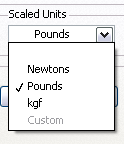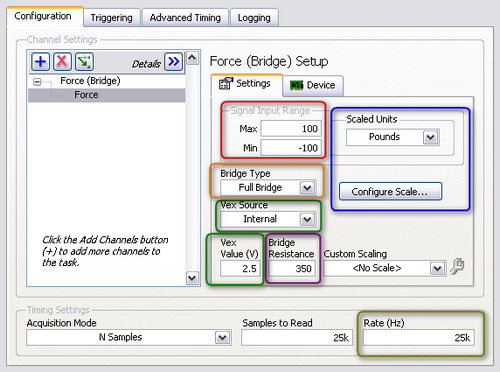DAQmx 9.1 and Later
- Select Create New NI-DAQmx Task by either right-clicking NI-DAQmx Tasks or in the toolbar.
Figure 1: Create a new task
- Create a Force (Bridge) task and select the device channel(s).
- Enter the Task Name.
This may be left as the default value; however, a custom name will be easier to reference in your program.
- Configure the settings for your device.
Each section below has a color listed in parenthesis that corresponds to its location on the Figurte 3 below.
- Signal Input Range (Red) - The upper and lower limits of the transducer in the force unit, i.e. pounds, Newtons, kilograms (force) .
- Voltage Excitation (Vex) Source (Green) - Select the excitation source for the load cell. Internal Excitation means the NI 9237 is supplying the voltage. An external power supply must be used during External Excitation and the source is connected to the NI 9237 via the terminals near the bottom of the module.
See the specifications for your load cell to determine the amount of excitation needed. The NI 9237 can provide 2.5 V, 3.3 V, 5 V, or 10 V of excitation. If a different value is selected, then the module will default to the nearest value from the list provided.
It is not possible to use a combination of Internal Excitation and External Excitation as there is an internal hardware difference depending on the selection.
Note: As stated in the NI 9237 Specifications, linked below, the total maximum power supplied by the NI 9237 is 150 mW. If more power is needed, then use external excitation provided by an another source.
This is less of a concern with passive sensors, i.e. strain gauge based sensors, as the change in resistance is measured from stimulation. Verify the power requirements when using sensors that require circuitry to be powered, i.e. TEDS, where under-powering the transducer could cause incorrect readings. For more information about passive transducers, see Knowledge Base: What Determines if a Transducer Is Active or Passive? in the Related Links section below.
- Bridge Type (Orange) -Refers to the sensor bridge type usually found in the sensor's specifications. The NI 9237 is a half or full bridge analog input module. A quarter bridge sensor can be used if an external resistor is used to create a half bridge or use the NI 9944 or NI 9945 Quarter Bridge Completion Accessories.
- Scaled Units (Blue) - The NI 9237 will return readings in mV, thus a custom scale must be applied to obtain readings in another unit. By default this is automatically created with the Force (Bridge) task with options of Newtons, Pounds, and kilograms (force). Clicking the Scaled Units drop-down arrow will show additional options as shown below.
For unlisted units, create a Custom Voltage with Excitation task and apply a custom scale as explained in the DAQmx 9.0.2 and Earlier section.

Figure 2: Default scaled unit options
Select Configure Scale to launch the Configure Scale Dialog to customize the scaling parameters. See Knowledge Base: DAQmx Custom Scales in Measurement & Automation Explorer (MAX) for the NI 9237 in the Related Links section below.
- Bridge Resistance (Purple) - Specifies the resistance of the bridge sensor while not under load. This value is typically found in the sensor documentation under Terminal Resistance.
- Rate (Hz) (Gold) - Remember the NI 9237 has limited data rates and will coerce to the nearest available value. The following equation provides the available data rates of the NI 9237:
When using the internal master timebase of 12.8 MHz, the result is data rates of 50 kS/s, 25 kS/s, 16.67 kS/s, and so on down to 1.613 kS/s, depending on the value of n. See the NI 9237 Operating Instructions and Specifications in the Related Links for more information.

Figure 3: Configuration for a full bridge 350 Ohm transducer using 2.5 V of internal excitation with a range of +/- 100 pounds